Foundation Cracks: Causes, Seriousness and When To Worry
Home » Structural »
Foundations crack for many reasons including unstable soils, poor drainage and settling. Cracks may indicate serious structural problems and others may be insignificant. In the United States approximately 60% of homes are built on soils with some clay content; of these more than half of the homes will experience damage. Soils with a heavy clay content may result in a foundation having a seasonally movement of 40 to 60 mm, 50mm equals about 2 inches. This soil movement is just one of a number of reasons that foundations crack or fail.
When are foundation cracks serious?
The seriousness of a crack depends on the location, size and number of cracks, as well as whether the home has other signs of structural issues. A large number of homes have cracks in their foundation and the older a home gets, the more likelihood of cracks appearing.
Cracked foundations can lead to framing issues, roof issues, problems with doors and windows and even leaks in basement walls. Correction of foundation and structural problems can be very costly and occasionally foundation cracks will be a warning sign of other structural issues with a home.
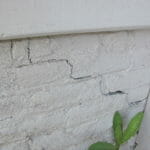
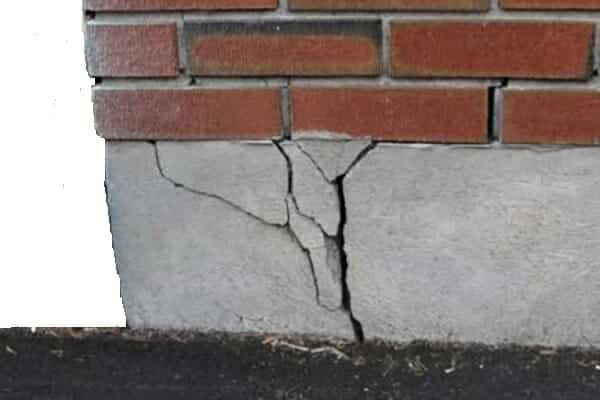
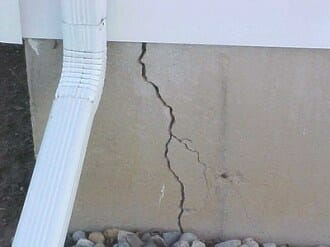
98% of the homes in the United States have foundations constructed out of concrete, masonry blocks or brick, all of which tend to crack when there is movement and excessive stress. In areas with expansive soils (clayey type soils) there is usually more soil and foundation movement than in other areas. In areas with extreme clay content, some foundations will shift up and down as much as an inch or two inches seasonally; usually causing foundation cracks.
Understanding cracks: What you should know
- Causes of cracks
- Types of cracks
- How to analysis cracks
- Maintenance and prevention
- Know the “Bottom Line”
Reasons for foundations cracking or failing
Foundations crack or become damaged for many reason. Following is a partial list of causes:
Tree roots. Roots may cause cracks, however, foundations rarely crack from the roots pushing up, but from them drawing the moisture out of the soil under the foundation due to “Transpiration.” Read about Transpiration
Settlement. If a foundation settles, cracking may occur, especially if there is differential settlement.
Expansive soils. In soils with a clay content, especially a high clay content, heaving or lifting pressures of the soils may crack the foundation. (More about expansive soils )
Drainage issues. Poor drainage near a home’s foundation is actually one of the more common causes of foundation cracks and damage.
Plumbing leaks. When plumbing leaks occur, either from water lines or sewer lines and the moisture migrates around or under a foundation, then cracking may occur. If the leak has been going on over a long period of time, then the damage may be even greater.
Rotation of foundation. The foundation rotates (i.e. leans slightly outwardly or inwardly).
Poor soil compaction. If the soil was not properly compacted before digging the footings, then the foundation may drop down a little and crack. The soils basically fail to support the weight of the foundation and house.
Subsidence. The sinking of the ground in small or large areas, often due to water being pumped from underground aquifers or wells, underground mining operations or sink holes.
Engineering. Foundations not properly sized and engineered for the type of soils and the loads that the foundation is carrying will create cracks.
Second story added. If a home has a second story added and the original footings were not designed for a two story building or strengthen for the added weight, then cracks may appear.
Reinforcement. No rebar (steel reinforcement) or insufficient rebar in the foundation.
Frost uplift or heaving. In cold climates where the ground freezes a foundation may be subject to damage if the frost / freezing gets below the depth of the foundation or basement walls. (Read about frost heaving and ice lenses )
Geotechnical issues. Foundations exposed to an earthquake, a sink hole or landslide pressures or slope creep often develop cracks. (If home on sloping lot or hillside read about slope creep)
Warning signs that there may be a foundation problem
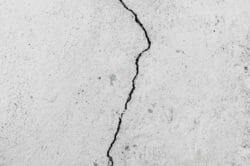
There are various signs that a homeowner or buyer may want to be aware of that could indicate that there is a possible foundation issue or concern.
Walking around the home, both the interior and exterior may alert you to seeking more information about the foundation. Naturally the most obvious sign is cracks visible in the foundation itself.
Walk around and look for the following:
- Sagging or wavy roof (Read more)
- Cracks in brick siding
- Stucco cracks
- Are there cracks at door and window corners
- Gaps at doors and window, racked or distorted
- Self-closing or opening doors
- Rubbing or sticking doors and windows
- Cracked or lose floor tile
- Cracks in the concrete slab or garage floor
- Sloped or un-level floors
- Creaking floors (Read more)
- Cracks in walls and ceilings
- Bowing or leaning foundation walls
- Chimney leaning away from house
How to evaluate and analyze cracks

When there are “yellow or red” flags of a possible foundation issues, first familiarize yourself with a little more information on what you observed; for the more you understand the reasons and causes of your observations, the better you can analyze the seriousness.
Often, after learning more about the reason or causes of a foundation crack, you will determine that things are normal or common and that you may just want to monitor the crack(s); i.e. are the cracks getting larger or growing in number over a period of six months or a year?
When there are cracks in the foundation it is always wise to look at the big picture. Ask yourself, are there a number of warning signs that there may be foundation issues; are there yellow or red flags.
Look for a concentration of issues and are they located in just one area of the home, such as the living room or the back half of the house. Check for patterns like crack patterns, movement patters such as a number of doors self- opening or closing; patterns are more important than an individual crack or occurrence when weighting the importance of your observations.
Look for geotechnical issues, for they’re more difficult to deal with than many other types of issues. Especially ones like slope creep.
Keep in mind that drainage issues are one the most destructive issues that may affect the foundation of your home but they are often the easiest and cheapest to correct.
Professional advice

At times a buyer or homeowner wants a second opinion or more information about their foundation or cracks but is not sure who to consult. There are different levels of knowledge about foundations and foundation issues and one professional may end up referring you to another professional based on what they have observed or their skill level.
Natural you want an appropriately qualified professional and you should verify that the person you consult with is appropriately qualified. Ones you may wish to speak with may include General Contractors, home inspectors, foundation engineers, geotechnical engineers and structural engineers.
Maintenance and prevention
Most homes lack ideal drainage and the drainage that was originally good when the home was first built has been changed by homeowners adding and changing the landscaping. Study if the trees near the foundation have grown and are causing foundation damage or may cause future damage to the foundation.
Check any yard drains to see if they’re free flowing and not clogged. Are the covers to the drains intact and not damage and are there areas where water may stand next to the foundation. Does the house have gutters and are they clean and in good repair; check that the downspouts are working properly and not discharging water near the foundation. Is the soil, walks and patio sloped away from the homes perimeter?
It is way cheaper to have a good maintenance and prevention program than it is to repair a foundation or a home.

Bottom Line
Many home foundations have cracks and they’re generally not serious, that just looking at a foundation crack or cracks will not really tell you whether a home has serious structural issues. The wise owner or buyer must really look at the big picture to determine the seriousness of foundation cracks.
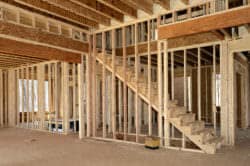
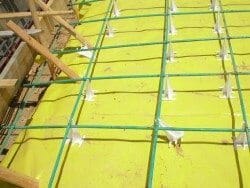








Who to call if there is a crack in the garage floor? It is a detached garage. Thanks